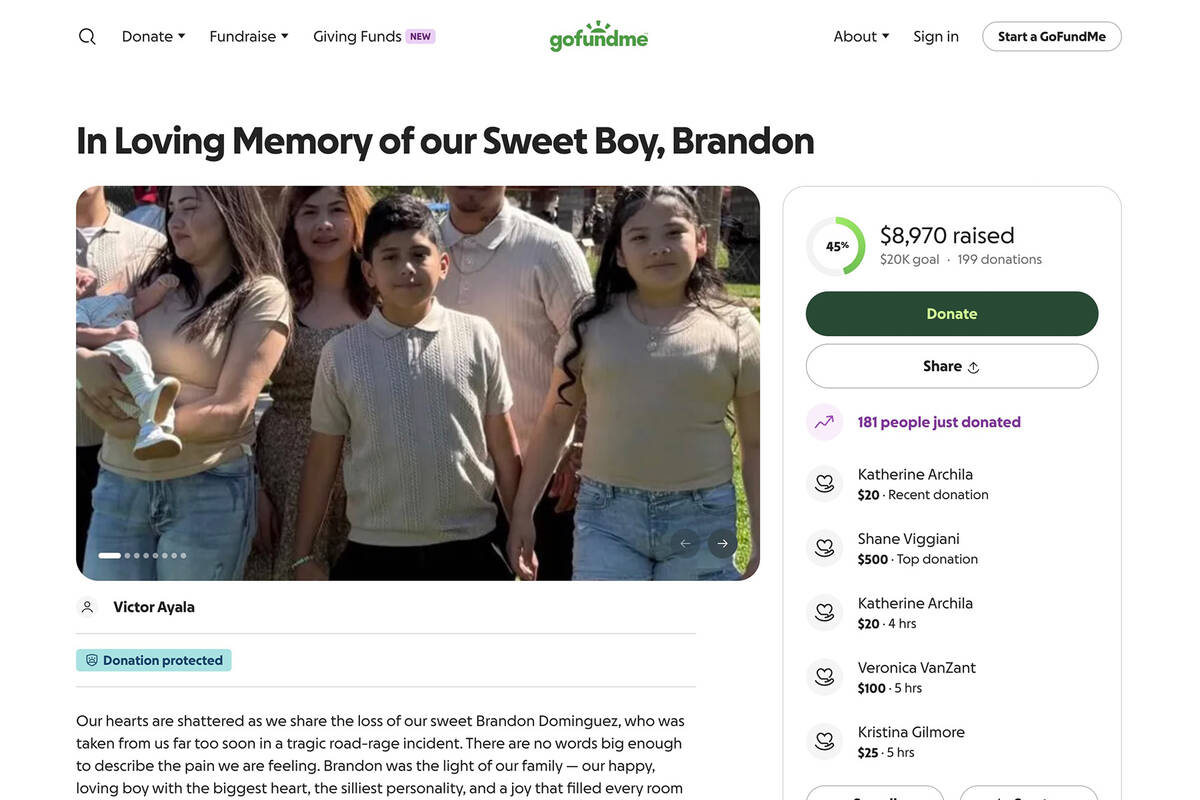‘I didn’t know there was a kid in the back,’ man accused of fatally shooting 11-year-old in road rage told police
The 22-year-old man accused of killing an 11-year-old boy during a road-rage shooting on the westbound 215 Beltway on Friday morning told police that he “did not know there was a kid in the back,” according to his arrest report.
Tyler Johns, who faces charges of open murder and two felony charges related to discharging a firearm from a vehicle into another vehicle, was arrested shortly after the admission.
“Tyler spontaneously admitted to officers that he had discharged his firearm into the black Chevrolet Traverse, and after admitting to the discharge of his firearm, he turned around and placed his hands behind his back without prompting from the officers, in what appeared to be a movement to allow them to place handcuffs on his wrists,” a Henderson Police Department detective said in the report.
Defense attorney Ryan Helmick, who now represents Johns, declined to comment Monday.
The shooting, which happened around 7:30 a.m. on the 215 near Gibson Road, involved a blue Hyundai Elantra driven by Johns and a black Chevrolet Traverse driven by Valente Ayala.
As Ayala tried to merge from Interstate 11 onto the 215, he and Johns started “jockeying” for positions on the beltway, cutting each other off and break-checking each other, a witness said in the report.
“It seemed like the driver of the black Chevy was angrier and the aggressor,” the witness, Edward Mack, also told police.
Both drivers rolled down their windows and began arguing before the driver of the sedan pulled out a handgun, firing once at the backseat of the SUV, police said.
Ayala’s stepson, Brandon Dominguez-Chavarria, 11, was in the backseat and struck in the head, according to the report. The two were on their way to his school, authorities have said.
A CCSD spokesperson said the boy attended Brown Elementary School, which is about a mile from where the shooting happened.
Over the weekend, the school sent a statement to parents that read in part, “It is with deep sympathy that I inform you of the recent passing of a student. It is never easy to lose a valuable life, especially at a young age, and we will truly remember them as part of our Brown Bear family.”
An online fundraiser identified the victim of the Friday shooting as Brandon Dominguez. The page was written by Victor Ayala, who is listed as Dominguez’s uncle, and described the boy as “the light of our family — our happy, loving boy with the biggest heart, the silliest personality, and a joy that filled every room he entered.”
As of Monday afternoon, the fundraiser had collected more than $24,000 toward its $20,000 goal.
According to the police report, Ayala and Johns continued to argue in the street after the shooting. An on-duty Metropolitan Police Department officer, who had been traveling on the beltway for an unrelated matter, was the first officer to respond to the scene.
“Valente was saying something to the effect that his son was dead and that [Johns] killed him. Valente was emotionally charged to a significant degree,” the Metro officer said in the report.
Dominguez-Chavarria was pronounced dead at the University Medical Center.
Ayala told police that he believed Johns intended to shoot him, but based on their speeds, the bullet struck the child. He also told police that he was not armed and did not own firearms.
After his arrest, Johns refused to talk with detectives at the police department, instead requesting an attorney. On Saturday, a Henderson Judge denied him bail.
“It’s a tragic case, so preventable,” said Frank Coumou, a former prosecutor who is now a criminal defense attorney. “It’s one of these situations where two hot tempers got involved and rational thought didn’t take over, unfortunately, and now we have a tragedy where a young, 11-year-old boy gets murdered while he’s on his way to school, something very innocent.”
The legal idea of transferred intent could apply to the situation, Coumou said.
Transferred intent comes into play when a shooter hits someone other than the intended victim, but is still held legally responsible for the crime.
“If they did not have a legal right to fire their gun, then they’re responsible for whatever happens when they pull the trigger,” said David Roger, the former Clark County district attorney.
Coumou also suggested Johns might make a self-defense argument.
“I could see where maybe Johns will argue that he felt so threatened and that he had to use deadly force because the stepdad was acting in an erratic way and using his car as a deadly weapon,” said Coumou.
Roger said defendants in road rage cases frequently argue that they are actually the victim.
Depending on the defendant’s perception at the time, it could be a self-defense case, he said.
Review-Journal reporter Noble Brigham contributed to this report.
Contact Akiya Dillon at adillon@reviewjournal.com.



















